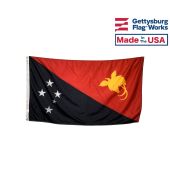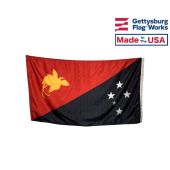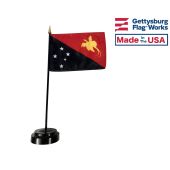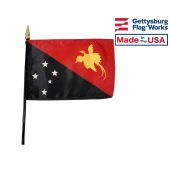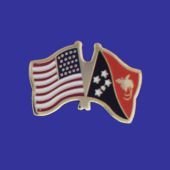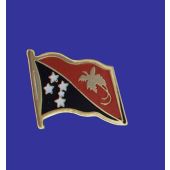Papua New Guinea Flags

Flag of Papua New Guinea
The Papua New Guinea flag is the latest in a long line of flags that stretches back through almost a century of colonial history. The current Papua flag shows some influence from the earliest of the colonial flags, but it also includes new symbols of the nation and its people that ensure that the flag is a symbol of the modern nation in addition to its role as a link to the country's history.
The flag of Papua New Guinea was adopted on July 1, 1971. In the hoist, it depicts the Southern Cross; in the fly, a raggiana bird of paradise is silhouetted. The designer of the flag was 15 year old schoolgirl Susan Huhume who won a nationwide competition for a new flag design in 1971. Red and black have long been traditional colours of many Papua New Guinean tribes. Black-white-red was the colour of the German Empire's flag, which had colonised New Guinea prior to 1918. The bird of paradise is also found on the national coat-of-arms.
Prior to 1970, Papua New Guinea was known as the Australian Trust Territory of Papua and New Guinea, and its flag for sporting events was the bird of paradise on a green background. In 1970 the Australian Administration tried to introduce another flag, a vertical triband: blue at the hoist with the stars of the Southern Cross (Crux Australis) as in the Australian flag, then yellow, then green with the white bird of paradise in the fly.
- Capital of Papua New Guinea: Port Moresby
- Area of Papua New Guinea: 452,860 sq. km
- Languages used in Papua New Guinea: Melanesian Pidgin, English, Motu
- Religions in Papua New Guinea: Roman Catholic, Lutheran, Presbyterian/Methodist/London Missionary Society, Anglican, Evangelical Alliance, Seventh-Day Adventist, other Protestant, indigenous belief
Colors and Symbolism of the Papua Flag
The Papua flag is divided into two sections by a diagonal line that runs from the upper-hoist corner of the flag down to the lower-fly corner. The lower of the two sections is black, while the upper portion of the flag is red. Both sections of the flag also include an emblem. The lower portion depicts the Southern Cross constellation in white, while the upper portion contains a golden raggiana bird-of-paradise. The black and red portions of the flag serve as a link to the flag of the German Empire, which began the country's colonization, but they were also common symbols of the native tribes of Papua New Guinea. The constellation represents the nation's location in the Southern Hemisphere, and the bird-of-paradise is a symbol of the nation's wildlife that can also be found on the national coat of arms.
History of the Papua New Guinea Flag
The German flag began to fly over New Guinea in 1899. Both the national flag of Germany and a specific colonial flag were used. The national flag was made up of three horizontal stripes of black, white, and red. The colonial flag had a white field with the national flag in the canton and a black lion holding a red lily in the fly. It flew over the nation until 1914, at which point the colony passed to British control. The British colony flew a flag that consisted of a blue field with the Union Jack in the canton and the colonial seal in the fly. British New Guinea merged with British Papua in 1949, which created the colony of Papua New Guinea. The flag of New Guinea was retained as the Papua New Guinea flag, while the similar colonial flag of Papua fell out of use.
The nation became a trust territory and adopted a green flag decorated with a bird-of-paradise in 1965. It was replaced with a more complex design in 1970, which gave way to the modern flag in 1971.
